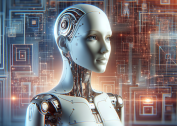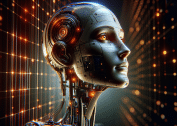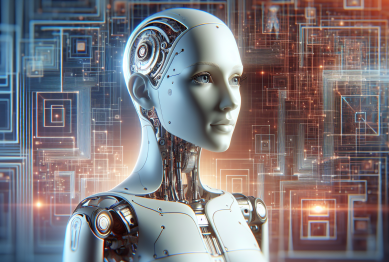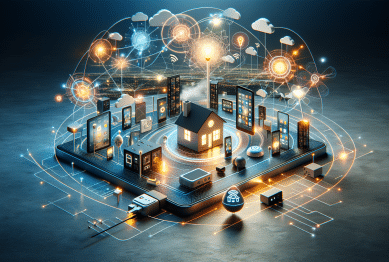Introduction
Robotics and artificial intelligence (AI) are no longer confined to research labs and science fiction movies. Today, they are at the forefront of innovation, revolutionizing industries and redefining the future of work. From manufacturing to healthcare, AI-driven robots are transforming industries by boosting efficiency, reducing costs, and improving safety. In this article, we’ll explore how AI is shaping the future of robotics and the transformative impact it’s having across various sectors.

The Rise of AI in Robotics: A Brief Overview
The integration of Artificial Intelligence (AI) in robotics represents one of the most transformative advancements of the 21st century. Unlike traditional robots that rely on pre-set instructions, AI-powered robots have the ability to learn, adapt, and make autonomous decisions through data analysis. This evolution is unlocking new possibilities in industries where precision, speed, and safety are critical, ushering in an era of intelligent automation.
Key Industries Being Transformed by AI Robotics
1. AI-Powered Robotics Revolutionizing Manufacturing
Manufacturing has always been at the forefront of adopting robotics, but the inclusion of AI is pushing the sector to unprecedented levels. With AI, robots are now equipped with machine learning algorithms, enabling them to detect defects, adapt to different production lines, and predict maintenance requirements.
Example: At Tesla’s Gigafactory, AI-powered robots streamline the production of electric vehicles. These robots learn from historical data to enhance welding accuracy and speed, ensuring superior product quality while minimizing costs.
2. Healthcare Robotics: AI Enhancing Medical Precision
In healthcare, AI-powered robots are transforming patient care and surgical procedures. From robotic-assisted surgeries to automated drug dispensing, the role of robotics in healthcare is rapidly expanding.
Example: The da Vinci Surgical System leverages AI to aid surgeons in conducting minimally invasive procedures with greater precision and control. This not only reduces recovery times but also lowers surgical risks, offering better outcomes for patients.
3. Logistics and Automation: AI’s Role in Optimizing Operations
The logistics and warehousing sectors are increasingly relying on AI robots to optimize supply chains and manage inventories. AI-enabled robots handle complex tasks such as sorting, packing, and transporting goods across expansive distribution centers.
Example: Amazon Robotics, previously known as Kiva Systems, employs a fleet of AI-guided robots to streamline order fulfillment. These autonomous robots navigate the warehouse floors with precision, significantly reducing human intervention.
How AI is Driving New Robotics Innovations
AI’s integration into robotics is paving the way for groundbreaking innovations that were once considered science fiction. Below are some of the latest advancements:
- Collaborative Robots (Cobots): Unlike traditional robots that operate in isolation, cobots are designed to work alongside humans, boosting productivity and safety. Cobots are gaining traction in sectors such as automotive and electronics, where precision and flexibility are essential.
- AI-Powered Vision Systems: These systems enable robots to “see” and interpret their surroundings, using AI and advanced imaging technologies. Robots equipped with these systems can identify objects, read barcodes, and detect quality variations, making them invaluable in manufacturing and logistics.
- Robotics as a Service (RaaS): AI and cloud computing are driving a new business model known as RaaS. This model allows companies to deploy robotic solutions on a subscription basis, reducing the need for hefty upfront investments and making robotics accessible to small and medium-sized enterprises.
Challenges Facing AI in Robotics
Despite its rapid growth, several challenges hinder the widespread adoption of AI in robotics:
- Data Privacy and Security: AI robots heavily rely on data, making them vulnerable to cyber threats. Ensuring robust data security and privacy protocols is paramount for organizations implementing AI-driven robotics.
- High Initial Costs: While the long-term benefits of AI robotics are substantial, the initial implementation costs can be prohibitive, especially for small businesses. Overcoming this barrier is essential for broader adoption.
- Ethical and Employment Concerns: The increasing use of AI in robotics has raised ethical questions regarding job displacement and the role of robots in decision-making. Striking a balance between automation and human employment is a challenge that industries must address to foster sustainable growth.
The Future Outlook: What Lies Ahead for AI-Powered Robotics?
The future of AI in robotics is incredibly promising, with emerging trends set to revolutionize various industries:
- AI-Powered Healthcare Assistants: Look forward to robots that provide emotional support and companionship for elderly patients, improving their quality of life.
- Smart Agriculture: AI-integrated robots will play a critical role in precision farming, utilizing real-time data to optimize crop yields and reduce resource use.
- Autonomous Vehicles: AI is making significant strides in self-driving technology, with potential applications in both the transportation and logistics sectors.
Industry Forecast: According to the International Federation of Robotics, the global stock of operational industrial robots is projected to reach 4 million units by 2025 (International Federation of Robotics, 2022). This growth reflects the increasing reliance on AI-powered robotics across diverse sectors.
Conclusion: AI Robotics — A Catalyst for Change
AI-powered robotics is set to redefine industries, create new business models, and transform our daily lives. From manufacturing and healthcare to logistics and agriculture, AI-driven robots are reshaping how we operate and interact. As technology continues to advance, the collaboration between humans and robots will become even more seamless, positioning AI as a pivotal enabler of future innovation and growth.
By embracing AI-driven robotics, industries are not only enhancing efficiency and precision but are also paving the way for a future where robots and humans can work together harmoniously to achieve greater outcomes.
References:
- International Federation of Robotics. (2022). Global Industrial Robot Report. Retrieved from IFR Website.
- Robotics Business Review. (2021). AI and Robotics: Driving the Next Wave of Innovation. Available at Robotics Business Review.
- Harvard Business Review. (2020). The Future of AI in Robotics. Accessed via HBR Website.









